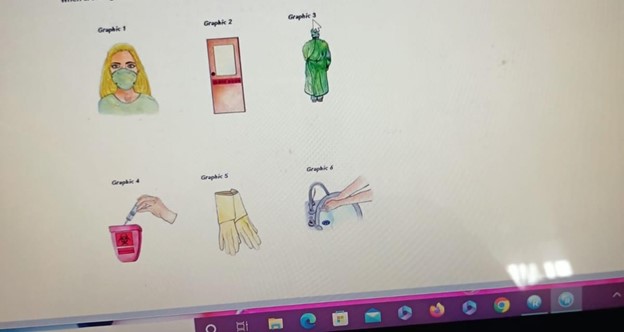A nurse is caring for a client who requires isolation for active pulmonary tuberculosis. Which of the following precautions should the nurse include when creating a sign to post outside of the client's room? (Select all that apply.)

please wear a mask
please wear a gown
dispose sharps here
please wear gloves
please wash your hands
radiation inside
Correct Answer : A,B,D,E
A. Wearing a mask helps protect against the transmission of airborne particles, which is important for preventing the spread of tuberculosis.
B. Wearing a gown can provide an additional barrier to prevent the transmission of infectious material.
C. Disposing sharps here is not directly related to tuberculosis precautions. This statement is more relevant for a sharps disposal container.
D. Wearing gloves is important to prevent direct contact with potentially contaminated surfaces.
E. Hand hygiene is crucial for infection control and should be emphasized for anyone entering or exiting the room of a client in isolation.
F. "Radiation inside" is not applicable to the isolation precautions for tuberculosis. This statement is unrelated to tuberculosis precautions and may cause confusion.
Nursing Test Bank
Naxlex Comprehensive Predictor Exams
Related Questions
Correct Answer is A
Explanation
A. Determining the location of the pain is the first step in assessing and managing a client's pain. It helps the nurse gather important information about the nature and potential causes of the pain.
B. Administering the medication may be necessary, but it should come after the nurse has assessed the location and characteristics of the pain to ensure the correct medication and dosage are given.
C. Repositioning the client can be important for comfort and pain relief, but it should come after the nurse has assessed the location of the pain to determine the best position for the client.
D. Reviewing the effects of the pain medication is important, but it should come after the nurse has administered the medication. It is essential to first address the client's request for pain relief by assessing the pain location and administering the appropriate
medication.
Correct Answer is B
Explanation
A. The head of the bed should generally be elevated no more than 30° to reduce shear and friction, not 45°.
B. Using a transfer device to lift the client prevents shearing and friction, which helps maintain skin integrity and reduces the risk of pressure ulcers.
C. Massaging bony prominences is not recommended, as it can damage underlying tissue and increase risk of ulcer formation.
D. Cornstarch is not advised because it can create a moist environment that promotes skin breakdown and infection.
Whether you are a student looking to ace your exams or a practicing nurse seeking to enhance your expertise , our nursing education contents will empower you with the confidence and competence to make a difference in the lives of patients and become a respected leader in the healthcare field.
Visit Naxlex, invest in your future and unlock endless possibilities with our unparalleled nursing education contents today
Report Wrong Answer on the Current Question
Do you disagree with the answer? If yes, what is your expected answer? Explain.
Kindly be descriptive with the issue you are facing.
